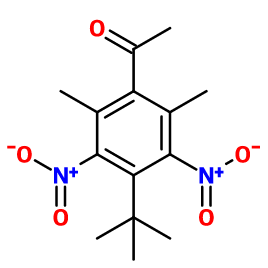
Photo credits: ScenTree SAS
Musk ketone
1-(4-tert-butyl-2,6-dimethyl-3,5-dinitrophenyl)ethanone, 1-acetyl-4-(tert-butyl)-2,6-dimethyl-3,5-dinitrobenzene, 4-tert-butyl-2,6-dimethyl-3,5-dinitroacetophenone, 1-(4-tert-butyl-2,6-dimethyl-3,5-dinitrophenyl)ethanone, 4-tert-butyl-3,5-dinitro-2,6-dimethylacetophenone, 1-(4-(1,1-dimethylethyl)-2,6-dimethyl-3,5-dinitrophenyl)ethanone, 1-(4-(1,1-dimethylethyl)-2,6-dimethyl-3,5-dinitrophenyl)-ethanone, ketone moschus, muskketone

Photo credits: ScenTree SAS
Do you sell any of the raw materials? Would you like to let our users know?
Send an email to fournisseurs@scentree.coto learn about our advertising opportunities.
Do you sell any of the raw materials? Would you like to let our users know?
Send an email to fournisseurs@scentree.coto learn about our advertising opportunities.
General Presentation
-
CAS N° : 81-14-1
-
EINECS number : 201-328-9
-
FEMA number : Donnée indisponible.
-
Density : 1,205
-
Optical rotation : Donnée indisponible
-
Allergens : This ingredient does not contain any allergen.
-
Refractive Index @20°C : Donnée indisponible
-
Volatility : Base
-
Price Range : €€
-
Appearance : Yellow powder
-
FLAVIS number : Donnée indisponible.
-
JECFA number : Donnée indisponible.
Information on synthetic ingredients
-
Acid Value : Donnée indisponible
-
Boiling Point : 395°C
-
Detection Threshold : 0,1 ng/l air
-
Molecular formula : C14H18N2O5
-
Log P : Donnée indisponible.
-
Molecular Weight : 294,31 g/mol
-
Fusion Point : 135°C
-
Flash Point : 100°C
-
Vapor pressure : Donnée indisponible
Uses
Other comments :
Musk Ketone is part of the nitrated musk family. Since 1998, it is also the only nitrated musk authorized in perfumery. The others are considered to be toxic and are banned by the IFRA. It is however very probable that the regulatory authorities will prohibit it in the coming years because of the 'precautionary principle'.
It is common to see anosmies on this musk.
Stability :
Musks are very stable, as in alcoholic and in functional fragrances
Uses in perfumery :
Musk Ketone is used in women perfumes for a powdery effect. Goes on well with white flowers accords.
Solubilization issues in alcohol.
Mostly used in fine fragrance, less and less beacause of its vintage connotation.
Year of discovery :
Patented in 1893 by Willem Mallmann and transferred to the Laire factories in 1896. The reason? W. Mallmann illegally produced this compound chemically very close to musk Xylene, itself patented by the Fabriques DeLaire in 1888.
Isomerism :
Musk Ketone is a nitrated musk with no isomer used in perfumery.
Synthesis precursor :
Musk Ketone is not a precursor to the synthesis of another compound of olfactory interest.
Natural availability :
Musk Ketone is not available in its natural state.
Synthesis route :
Musk Ketone is synthesized from 1,3-dimethyl-5-tert-butylbenzene, by a Friedel-Craft acetylation, with chloroacetic acid and in the presence of aluminum chloride. This reaction is followed by a nitration of the obtained compound with nitric acid.
Regulations & IFRA
-
IFRA 51th : This ingredient is restricted by IFRA
-
Restriction type : SPECIFICATION
-
Cause of restriction : SEE FRAGRANCE INGREDIENT SPECIFICATION
-
Amendment : 45
Comments :
Musk xylene (CAS number 81-15-2), which has been prohibited for use in fragrance compounds for environmental reasons (vPvB), can be present in Musk ketone as an impurity. Musk ketone should only be used if it contains less than 0.1% of Musk xylene.

